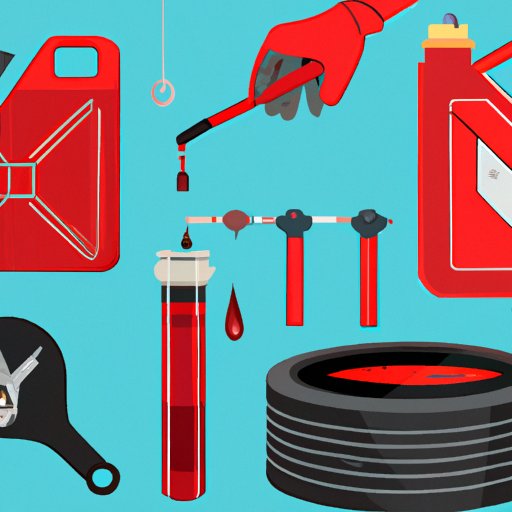
I. Introduction
Regular maintenance of your car is critical to ensure a long and reliable life for your vehicle. Changing your car’s oil frequently and accurately can help extend the lifespan of the engine. The oil lubricates engine parts while reducing friction, protecting the engine from wear, and dislodging any debris. Maintaining your car’s oil can also help increase fuel efficiency and reduce emissions.
II. Step-by-Step Guide
Here is a comprehensive guide to changing the oil in your car:
- Park your car on a flat surface and turn off the engine.
- Identify the oil drain plug, which is located under the car. Position a catch pan under the plug.
- Loosen the oil drain plug and remove it by turning counterclockwise. Allow the oil to drain completely.
- Unscrew the oil filter using an appropriate tool and dispose of it properly.
- Dip your finger in new oil, lubricate the rubber seal on the new oil filter, and replace the old filter with the new one.
- Replace the oil drain plug and tighten it securely.
- Use a funnel to add the recommended amount of oil through the oil filler hole located on top of the engine.
- Replace the oil filler cap and start the engine to circulate the new oil.
- Check the oil level using the dipstick to confirm it is at the correct level. Add more oil if necessary and recheck the fluid level.
- Dispose of used oil and filter properly.
It is essential to follow the vehicle manufacturer’s instructions for the type and amount of oil required before changing your oil.
III. The Importance of Changing Oil
Changing oil is crucial for maintaining your car’s health. Without regular oil changes, dirt and debris build up in your car’s engine. The engine may become less efficient or altogether fail due to the added stress and wear. A lack of proper maintenance can lead to engine overheating, decreases fuel efficiency, and risks major engine damage.
IV. DIY Oil Changes
Changing your oil yourself is not only a money-saving alternative to bring your car into a mechanic, but it can also be a fun do-it-yourself project. Be sure to review your car’s manual to understand how much and what type of oil to use, explore the steps of changing your oil further, and make sure to acquire the appropriate tools.
Changing your car’s oil comes with potential risks, including burns from hot oil or other engine components, slipping while beneath the car, and losing track of nuts and bolts. Be sure to exercise care when handling oil, wear gloves, and consider additional safety measures such as eye protection and non-slip safety boots.
V. How to Choose the Right Oil
Choosing the right type of oil and filter is essential to protect your engine. Your vehicle manufacturer’s recommended oil and filter should be based on engine size, typical driving conditions, and climate. If you don’t have a manual, synthetic oils are often more efficient, and oils with thicker weight are optimal for older cars. Read the label on the oil packaging carefully to confirm that it meets your car’s specifications before making a purchase.
VI. Tools You Need to Change Your Oil
Most of the time, you will need oil filter wrenches, oil drain pans, oil filter plugs, funnels, safety gloves, and cloths to change your oil successfully. Depending on the location of your oil filter and where you will be working under your vehicle, you may also need low profile jacks to raise your car off the ground. Lubricants and penetrating oil may also prove helpful during the oil changing process. Make sure to buy the accurate and suitable tools to ensure a successful oil change.
VII. How Often Should You Change Your Car’s Oil?
The recommended timeline for changing your car’s oil will differ depending on the car. Vehicles driven in severe conditions such as hot temperatures, long-distance travel, and stop-and-go traffic may require more frequent oil changes. For average driving conditions, changing the oil every 3,000 miles or every three to six months is practical. Consider checking your vehicle owner’s manual to see specific guidelines for recommended oil change times in your area.
VIII. Hacks for Quicker Oil Changes
Here are some hacks to help you change your oil faster:
- Warm up your car for a few minutes to help the oil flow more readily.
- Invest in an oil extractor to avoid having to remove your car’s oil filter or drain plug.
- Use a high-performance air filter to extend your oil change interval.
- Consider investing in a magnetic oil drain plug to catch any metal debris in the engine.
- Try adding an oil stabilizer to keep your engine running smoothly.
IX. Conclusion
Changing your car’s oil is a critical piece of car maintenance, helping keep your car running smoothly for years to come. By following our step-by-step guide, tips on safety and choosing the right oil, you can achieve a successful oil change and avoid costly engine damage. Always remember to dispose of used oil and filters properly, use caution when handling hot oil, and have fun while taking care of your car.




